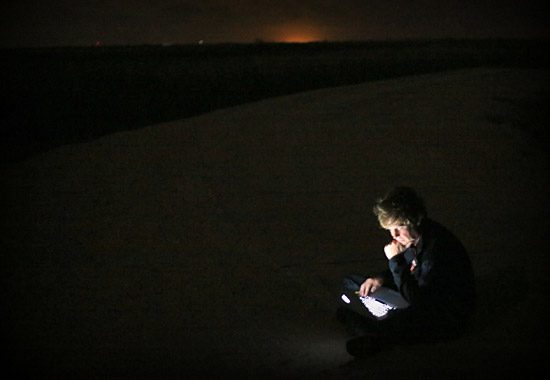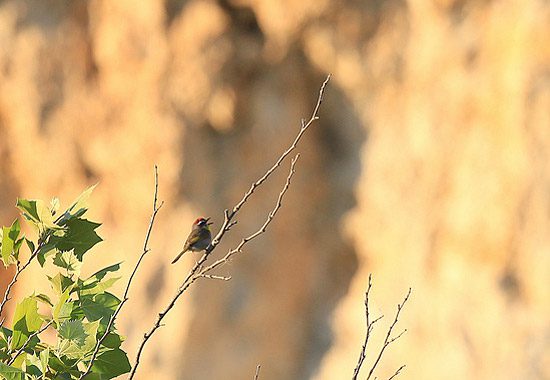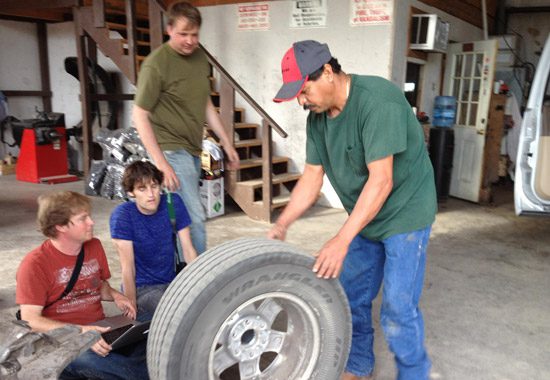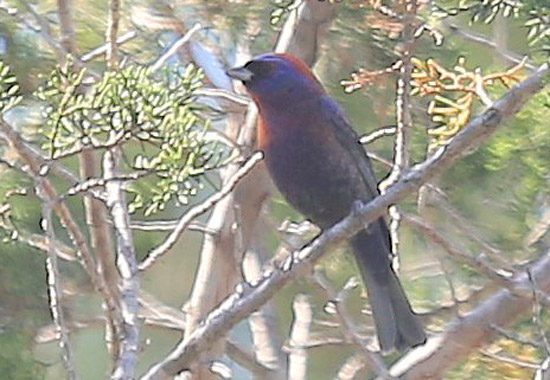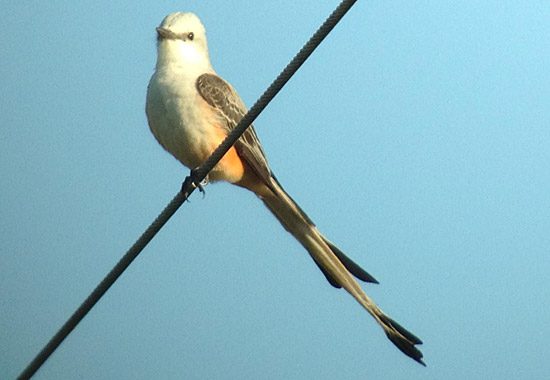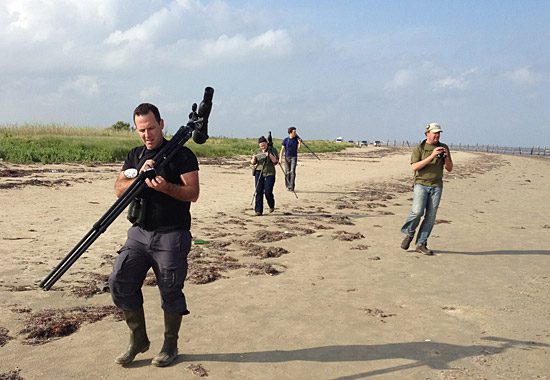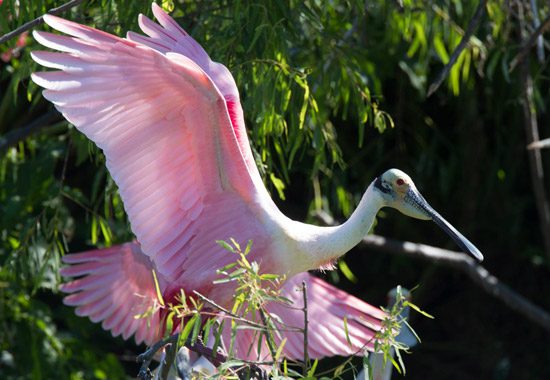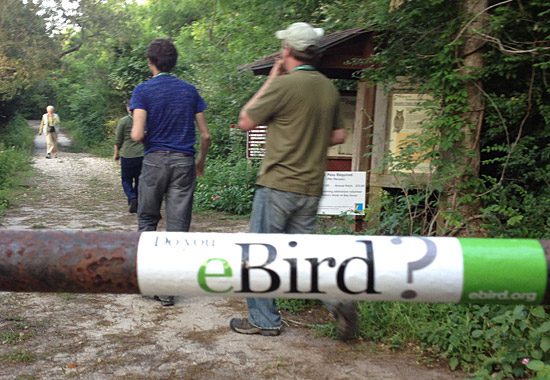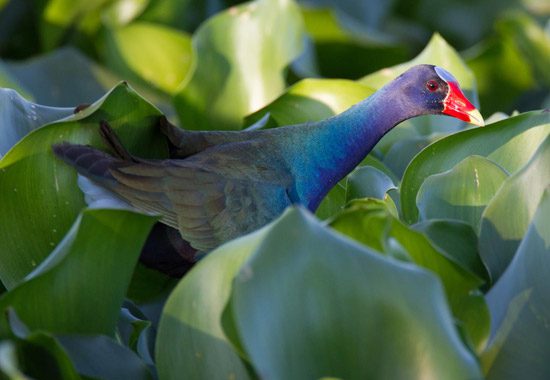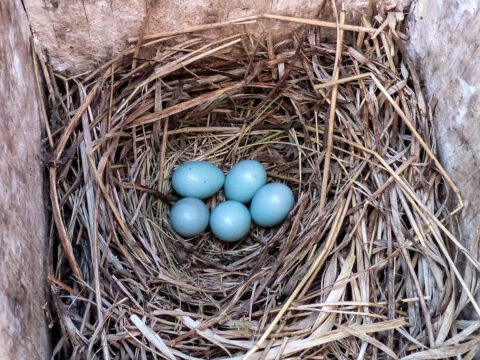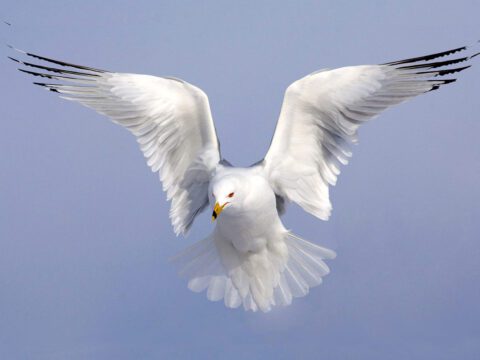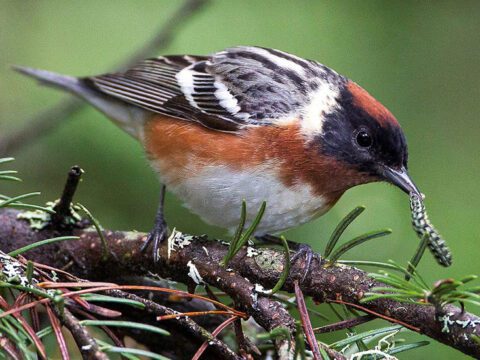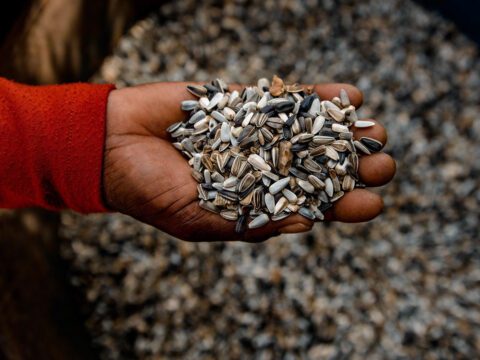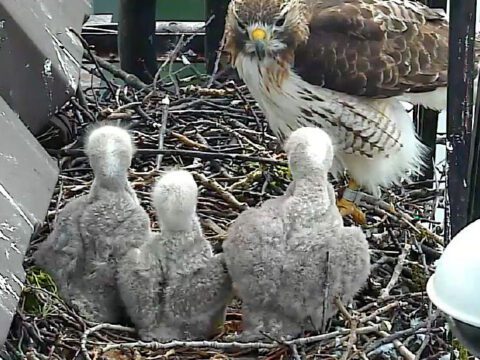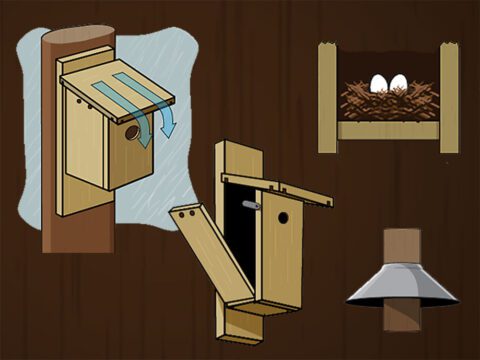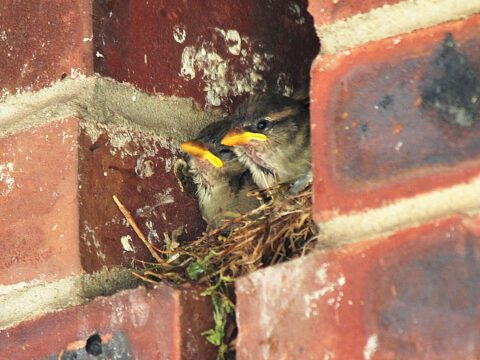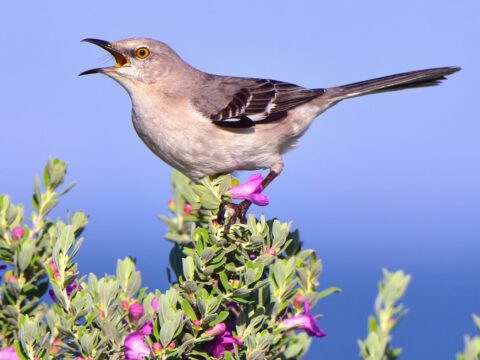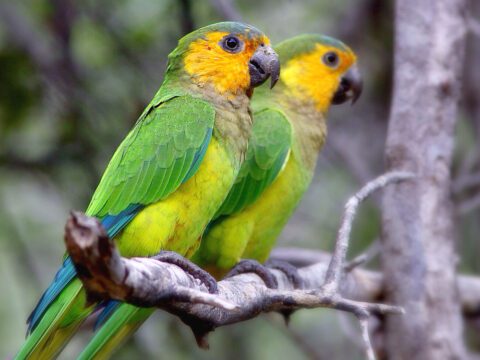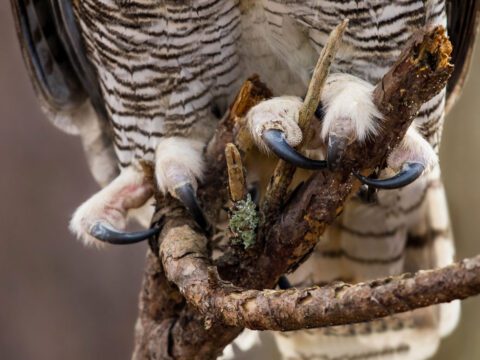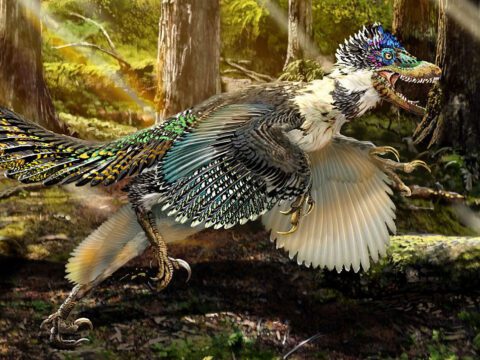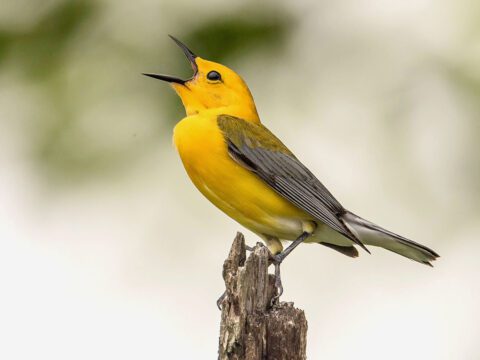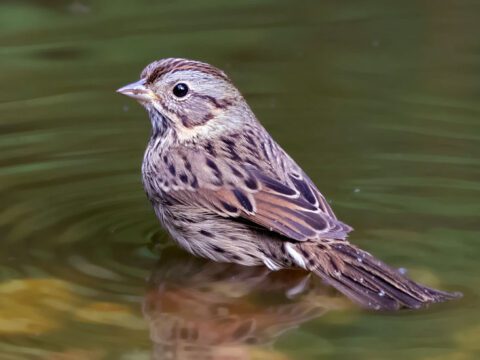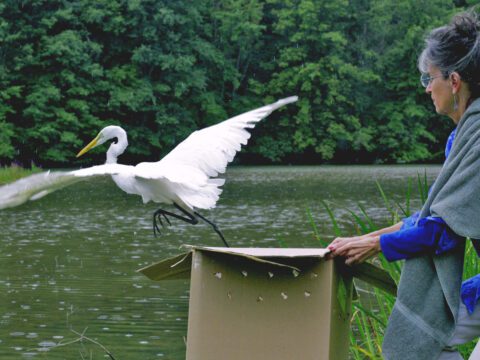Sapsuckers Overcome Mishaps, Misfortune to Tie Their Big Day Record [video]
By Hugh Powell May 1, 2012
Marshall Iliff makes the final tally just after midnight—264 species for the day. 
Big Day 2012 dawned near the Mexico border with birds like this Rufous-capped Warbler. 
A flat tire put a crimp in Team Sapsucker's precision-timed schedule. 
The Hill Country produced fabulous birds like this Varied Bunting. 
Scissor-tailed Flycatchers are a fairly common and uncommonly beautiful Texas bird. 
By afternoon, the team was scouring Gulf Coast beaches for shorebirds. 
On a Big Day tally sheet, the incomparable Roseate Spoonbill counts the same as any other bird. 
Local support: three Sapsuckers (Chris, Marshall, Tim) work on our eBird project. 
Four minutes before midnight came bird #264: Purple Gallinule.
The concept of a Big Day is a bold one—a midnight-to-midnight sleepless birding blitz to see or hear as many species as humanly possible. Team Sapsucker—Chris Wood, Jessie Barry, Andrew Farnsworth, Marshall Iliff, and Tim Lenz—took on that challenge in Texas last year, setting the North American record at 264, and then they doubled-down for Big Day 2012, drawing up a never-before-tried-route that they hoped would net them even more birds.
Their run started in San Antonio in the wee hours of Friday, April 27. After a promising start, misfortune struck in the form of an old nail at a city dump, traffic in Houston, and a late-day shift in the sea breeze. By the time the clock struck midnight, the team had tied their own record of 264 species, getting their final bird with just four minutes to spare.
Big Day 2012 began at midnight with a Yellow-crowned Night Heron at Brackenridge City Park in San Antonio, then a sweep through the city that included a nesting American Robin beneath a streetlight. A flashlight scan yielded a swimming Least Grebe (as Barn and Great Horned owls called), and a bevy of ducks in the moonlight: Canvasbacks, Redheads, Wood Ducks, and Northern Pintails. Three of the team also heard an Elf Owl, but the other two missed it—crucially, as it turned out.
At daybreak, the Sapsuckers scooted west toward Uvalde, an area rich in Mexican birds. During scouting, Iliff had drawn up a plan to connect the dots between the birds, timed to when they began singing at dawn—a Tropical Kingbird at 6:20 a.m., a Green-tailed Towhee at 6:55 a.m., then a Ringed Kingfisher that regularly flew by the same spot at Chalk Bluff Park at 7:08 a.m. The Sapsuckers arrived at 7:04, but the kingfisher didn’t show. A precious half-hour ticked by. The team scooped up a Rufous-capped Warbler—one of very few records ever in the state—and an unexpected American Pipit, but still no Ringed Kingfisher. From there, the team rolled into the Uvalde Fish Hatchery, where the hatchery manager had granted the team special access to pick up Cinnamon Teal, Ring-necked Duck, and Yellow-rumped Warbler—three species the team didn’t see anywhere else during the day.
Next, the team made the fateful decision to go for a Chihuahuan Raven at the Uvalde city dump. They pursued one to the top of the landfill before a whishing sound grabbed their attention: a nail protruding from a rapidly deflating tire. And the spare tire storage mechanism wouldn’t release.
Time to call it quits and try again the following day? Not for team captain Chris Wood. “There are no ‘re-dos’ in Big Day,” he said. “A hockey team couldn’t get into the Stanley Cup playoffs, then decide they’re having a bad day and they want to try again tomorrow. Same thing with Big Day.”
The Sapsuckers pulled into Garza’s Radiator Shop in Uvalde and Wood, speaking Spanish, persuaded the repair man to do a quick fix. “Evidently, he likes birds,” Wood said. Farnsworth sprinted two miles to an ATM while Iliff, Barry, and Lenz huddled around their computer to recalibrate the route. Within 30 minutes the Sapsuckers were back on the road. They had to drop a few locations (and birds) from their route to make up time, but soon the team was in the Hill Country, where they nailed Black-capped Vireo, Golden-cheeked Warbler, and Varied Bunting in short order. Iliff called in a Greater Roadrunner, and by 11:08 the team was leaving the Hill Country for Houston—30 minutes behind schedule, but at roughly 150 birds for the day, a little ahead of where they had hoped to be on their Big Day list thus far.
On the four-hour drive to Houston, Farnsworth used his uncanny skill at long-distance spotting, picking out Cooper’s Hawk, Red-shouldered Hawk, White-tailed Hawk, and Franklin’s Gull from his seat in the back. When the team pulled over to verify the gull they found themselves standing atop a fire ant nest. A painful price, yet worth it, for a bonus bird that migrates at high altitudes and often flies right over Texas.
Near Houston, misfortune returned. Rice fields that were brimming with water, and waterfowl, just a day earlier were almost completely dried up. A flock of 25 Hudsonian Godwits was gone. A few shorebirds pecked around in the muck: Wilson’s Phalarope, Baird’s Sandpiper, and Buff-breasted Sandpiper. In a patch of piney woods in Houston, the Sapsuckers hit eastern species including Downy, Red-bellied, and Red-headed woodpeckers and Prothonotary and Pine warblers, but missed Great Crested Flycatcher. The misses were adding up.
So was the traffic in Houston. Still 30 minutes behind schedule, the Sapsuckers hit rush hour. Farnsworth used driving skills honed in Manhattan to weave through the gridlock and reach the route’s most critical point: the ferry to Port Bolivar. Miss that 4:30 connection, and their Big Day would be over. But the team arrived 15 minutes early—enough time for the authorities to conduct a full inspection of this suspicious-looking car filled with five people with binoculars. The team netted a Magnificent Frigatebird during the crossing, and the ferry arrived in port one minute early.
At Bolivar Flats, the team marched down the beach to rack up several gulls and terns, along with a Lesser Scaup, though they missed American White Pelican. In trees just off the beach, the team found a cluster of eastern migrants such as Rose-breasted Grosbeak, Indigo Bunting, and Baltimore Oriole. At High Island, a legendary spot for migratory songbirds, they scored 15 species in 75 minutes, including Cerulean, Magnolia, and Blackpoll warblers.
But then the sun went down, the winds picked up, and the birding came to a grinding halt. At Anahuac National Wildlife Refuge the team listened for marsh birds in the dark for three hours, adding only Seaside Sparrow, Yellow and King rails, and Common Gallinule. At 11:56 p.m., a Purple Gallinule called once, and that was it. The final bird for Friday, April 27.
Thirty seconds after midnight, several gallinules erupted into a chorus of laughter, and Team Sapsucker laughed right along with them. “It had been a tough day, and we all needed a good laugh,” Wood said.
Minutes later, Iliff tallied the day’s score in the dark, his face illuminated by the glow of his laptop screen. Jubilation at first—265 species, a new record!—then mellowed with the realization that the team had to subtract some birds due to the 95 percent rule. This rule states that 95 percent of the birds on a team’s list must be seen by everyone on the team. Upon double-checking the numbers, Iliff realized that that Elf Owl in San Antonio wasn’t unanimous. Off the list it came, and the day’s tally dropped to 264—a repeat of the record.
In tying the record—tallying 11 new species every hour of the day, or one new species every five and a half minutes, all day long—the Sapsuckers proved once again how remarkable a record of 264 species in 24 hours really is. More importantly, though, the generosity of all of our Big Day donors helped us raise needed funds for the Lab’s conservation work. Sponsorship by Carl Zeiss Sports Optics ensured that all donations go directly to conservation.
Of course, that doesn’t mean the Sapsuckers aren’t already thinking about getting just one more. As Farnsworth said, “We’ll definitely be coming back to Texas again next year.”
Though next time, they might avoid the dump.
Special Thank-You Video From Team Sapsucker
On the day after Big Day, the members of Team Sapsucker took a few minutes to say a big thank-you to all who donated or pledged in our biggest fundraiser of the year.
And for those of you keeping track at home, here’s Team Sapsucker’s Final Big Day 2012 List
(in taxonomic order)
Black-bellied Whistling-Duck
Fulvous Whistling-Duck
Wood Duck
Gadwall
American Wigeon
Mallard
Mottled Duck
Blue-winged Teal
Cinnamon Teal
Northern Shoveler
Northern Pintail
Canvasback
Redhead
Ring-necked Duck
Lesser Scaup
Red-breasted Merganser
Ruddy Duck
Northern Bobwhite
Wild Turkey
Pacific Loon
Common Loon
Least Grebe
Pied-billed Grebe
Brown Pelican
Neotropic Cormorant
Double-crested Cormorant
Anhinga
Magnificent Frigatebird
American Bittern
Great Blue Heron
Great Egret
Snowy Egret
Little Blue Heron
Tricolored Heron
Reddish Egret
Cattle Egret
Green Heron
Black-crowned Night-Heron
Yellow-crowned Night-Heron
White Ibis
White-faced Ibis
Roseate Spoonbill
Black Vulture
Turkey Vulture
Osprey
Swallow-tailed Kite
White-tailed Kite
Mississippi Kite
Northern Harrier
Cooper’s Hawk
Harris’s Hawk
Red-shouldered Hawk
Broad-winged Hawk
Swainson’s Hawk
White-tailed Hawk
Red-tailed Hawk
Crested Caracara
Peregrine Falcon
Yellow Rail
Clapper Rail
King Rail
Sora
Purple Gallinule
Common Gallinule
American Coot
Black-bellied Plover
Snowy Plover
Wilson’s Plover
Semipalmated Plover
Piping Plover
Killdeer
American Oystercatcher
Black-necked Stilt
American Avocet
Spotted Sandpiper
Solitary Sandpiper
Greater Yellowlegs
Willet
Lesser Yellowlegs
Upland Sandpiper
Whimbrel
Long-billed Curlew
Marbled Godwit
Ruddy Turnstone
Red Knot
Sanderling
Semipalmated Sandpiper
Least Sandpiper
White-rumped Sandpiper
Baird’s Sandpiper
Pectoral Sandpiper
Dunlin
Stilt Sandpiper
Buff-breasted Sandpiper
Short-billed Dowitcher
Long-billed Dowitcher
Wilson’s Phalarope
Laughing Gull
Franklin’s Gull
Ring-billed Gull
Herring Gull
Lesser Black-backed Gull
Least Tern
Gull-billed Tern
Caspian Tern
Black Tern
Common Tern
Forster’s Tern
Royal Tern
Sandwich Tern
Black Skimmer
Rock Pigeon
Eurasian Collared-Dove
White-winged Dove
Mourning Dove
Inca Dove
Common Ground-Dove
White-tipped Dove
Monk Parakeet
Yellow-billed Cuckoo
Greater Roadrunner
Barn Owl
Eastern Screech-Owl
Great Horned Owl
Elf Owl
Barred Owl
Lesser Nighthawk
Common Nighthawk
Common Pauraque
Common Poorwill
Chuck-will’s-widow
Chimney Swift
Ruby-throated Hummingbird
Black-chinned Hummingbird
Belted Kingfisher
Green Kingfisher
Red-headed Woodpecker
Golden-fronted Woodpecker
Red-bellied Woodpecker
Ladder-backed Woodpecker
Downy Woodpecker
Eastern Wood-Pewee
Acadian Flycatcher
Black Phoebe
Eastern Phoebe
Vermilion Flycatcher
Ash-throated Flycatcher
Brown-crested Flycatcher
Great Kiskadee
Tropical Kingbird
Couch’s Kingbird
Western Kingbird
Eastern Kingbird
Scissor-tailed Flycatcher
Loggerhead Shrike
White-eyed Vireo
Bell’s Vireo
Black-capped Vireo
Yellow-throated Vireo
Hutton’s Vireo
Red-eyed Vireo
Blue Jay
Green Jay
Western Scrub-Jay
American Crow
Chihuahuan Raven
Common Raven
Horned Lark
Northern Rough-winged Swallow
Purple Martin
Bank Swallow
Barn Swallow
Cliff Swallow
Cave Swallow
Carolina Chickadee
Tufted Titmouse
Black-crested Titmouse
Verdin
Cactus Wren
Rock Wren
Canyon Wren
Carolina Wren
Bewick’s Wren
Sedge Wren
Blue-gray Gnatcatcher
Black-tailed Gnatcatcher
Eastern Bluebird
Gray-cheeked Thrush
Swainson’s Thrush
Wood Thrush
American Robin
Gray Catbird
Northern Mockingbird
Long-billed Thrasher
Curve-billed Thrasher
European Starling
American Pipit
Cedar Waxwing
Tennessee Warbler
Orange-crowned Warbler
Nashville Warbler
Northern Parula
Tropical Parula
Yellow Warbler
Magnolia Warbler
Yellow-rumped Warbler
Golden-cheeked Warbler
Black-throated Green Warbler
Yellow-throated Warbler
Pine Warbler
Blackpoll Warbler
Cerulean Warbler
Black-and-white Warbler
American Redstart
Prothonotary Warbler
Ovenbird
Northern Waterthrush
Kentucky Warbler
Common Yellowthroat
Rufous-capped Warbler
Yellow-breasted Chat
Olive Sparrow
Green-tailed Towhee
Canyon Towhee
Cassin’s Sparrow
Rufous-crowned Sparrow
Chipping Sparrow
Clay-colored Sparrow
Field Sparrow
Lark Sparrow
Black-throated Sparrow
Lark Bunting
Savannah Sparrow
Grasshopper Sparrow
Le Conte’s Sparrow
Nelson’s Sparrow
Seaside Sparrow
White-throated Sparrow
White-crowned Sparrow
Summer Tanager
Scarlet Tanager
Northern Cardinal
Pyrrhuloxia
Rose-breasted Grosbeak
Blue Grosbeak
Indigo Bunting
Varied Bunting
Painted Bunting
Dickcissel
Red-winged Blackbird
Eastern Meadowlark
Western Meadowlark
Yellow-headed Blackbird
Brewer’s Blackbird
Common Grackle
Boat-tailed Grackle
Great-tailed Grackle
Bronzed Cowbird
Brown-headed Cowbird
Orchard Oriole
Hooded Oriole
Bullock’s Oriole
Baltimore Oriole
House Finch
Lesser Goldfinch
House Sparrow

All About Birds
is a free resource
Available for everyone,
funded by donors like you
American Kestrel by Blair Dudeck / Macaulay Library
